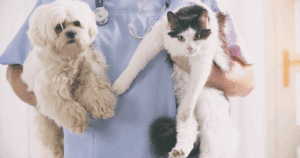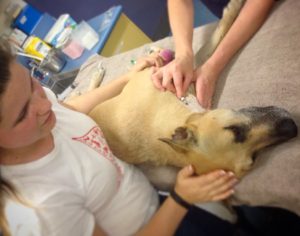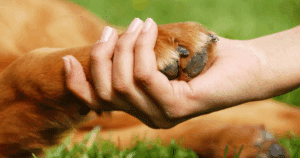
Often one of the main concerns people have around raw food diets is because they have been scared into believing bacteria in raw food will make their dog sick. We bust the myths around bacteria in raw food and discuss why it can be good for your dog with Veterinarian, Dr Duncan Houston.
Raw dog food tends to get a lot of bad press for its pathogenic potential and it’s important to put this into context. People have been conditioned to think bacteria is bad, but we need to know the distinction between good and bad bacteria and why we actually need some in our diets.
Dogs and cats have more acidic digestive systems than we do, which can counter a wider range of pathogens more effectively, but they also have shorter digestive systems, meaning that pathogens have less time to replicate and meat protein sources have less time to ferment within the intestines. We need to remember they are dogs and cats, not humans, so the “germ theory” needs to be applied differently.
I would use caution with raw foods if your pet is severely immuno-compromised, such as if they are on immuno-suppressive medications like chemotherapy drugs. It’s best to go chat to a professional about this if you have any concerns.
I do suggest adding prebiotics and probiotics (which are beneficial bacteria) to support the immune system when needed though, no matter what the diet.
A lot of scaremongering is done by vets that are conditioned to think a certain way about pet food. Commercial pet food manufacturers spend millions, if not billions of dollars on marketing kibble and lesser quality wet foods to both vets and consumers.
They make a lot of claims about the goodness they provide, whereas if you looked at the ingredients list and understood the impact certain ingredients and high carbohydrate levels are having on your dog’s health, you would actually start to understand the value that a raw food diet plays in good pet health.
Raw food diets do contain bacteria, pretty much all foods do. Technically almost everything has bacteria on it, but there is plenty of good bacteria that your pets’ actually need in their diet.
The problem is many dogs are no longer on a natural diet, so when a dog is introduced onto any new diet, or comes across a pathogen, their gut and potentially immune system do not recognise it, as in the animal’s body isn’t practiced at defending itself against it. This is why a dog might get sick if they have a raw bone or food and have been on a highly processed kibble diet, without it being slowly introduced first.
That’s right. We want to slowly transition them across to any new diet, especially if introducing raw, over 7-14 days. This is so that their stomach, intestinal tract and organs can slowly get used to any changes in nutrient levels as well as bacteria. Then over time they will be able to deal with the new diet like they should be able to. (For transitioning tips click here)
Pathogens are a normal part of the canine (and human) microbiome. Salmonella, e-coli, yeasts are all normally meant to be there, and are there irrespective of the food fed.
It all depends on how our bodies react to them as well and how well developed our own microbiomes and ultimately immune systems are – the same as it is for our dog.
Sterile food shouldn’t be the goal as this does nothing for the pets immune system nor the nutritional quality of the food.
It’s important to remember that small, daily immune system challenges that come from the environment, are an important part of keeping our pets’ immune systems in peak shape and ready to defend against something that may actually be life threatening.
Dogs sniff things, lick things and eat things that turn our stomachs, but it helps them in a variety of ways including their immune system function.
The immune system is like a muscle, it needs to be exercised to function at its peak. But also, we worry about pathogens with foods, when the fact is your dog will likely pick up something a lot worse on a walk or out in the backyard.
Yes, when it comes to raw feeding it’s important to distinguish the differences between our pets’ physiology and our own. So, when handling raw food, whether it be our food or for our pets, we do need to be aware of hygiene.
I always suggest selecting a pet food or to use food that is human grade. Foods that aren’t human grade quality or just pet-grade can potentially have higher levels of pathogens and additional not nice things, like certain preservatives.
Also, with bacteria it’s a numbers game. Pets need some bacteria but not too much and they need the right kinds. Human-grade produce is important, as these have a lower bacterial load than pet-grade mince and it’s a numbers game when it comes to the bacteria pets can handle in raw food.
I think freezing as a method of preservation is the best practice for raw foods.
Freezing stops the replication of bacteria after manufacturing until it can be thawed and ready to feed. But be wary of raw food products that have extended shelf lives in the fridge alone. There isn’t currently any commercially available process that will extend the shelf life of raw food beyond a few days in the fridge without effecting the nutrition.
You also need a company that manufactures the food in a clean facility. Transparent pet food manufacturers will show you behind the scenes footage of their food being made, not right after clean-down if they have nothing to hide, which is a great sign of a raw food brand that you can trust.
Freezing is the best way to preserve raw food until its ready to thaw to feed, this stops the replication of bacteria after manufacturing until ready for use.
Be wary of raw food products that have extended shelf lives in the fridge alone – there is currently no commercially available process that will extend the shelf life of raw food beyond a few days in the fridge without effecting the nutrition.
In addition to this manufacturing in a clean facility – transparent pet food manufacturers will show you behind the scenes footage of their food being made (not right after a clean down!) if they have nothing to hide which is a great sign of a safe raw food brand. That’s why I use and recommend Big Dog Pet Foods.
If you’d like to find out more about feeding your dog a Big Dog raw food diet, visit their website.


Dog blood donations save lives



Keeping your pet safe from Paralysis Tick


Get your paws on Lara Shannon’s best selling books ‘Eat, Play, Love (your dog) and World of Dogs.
Available in Australia, USA, UK and Canada.